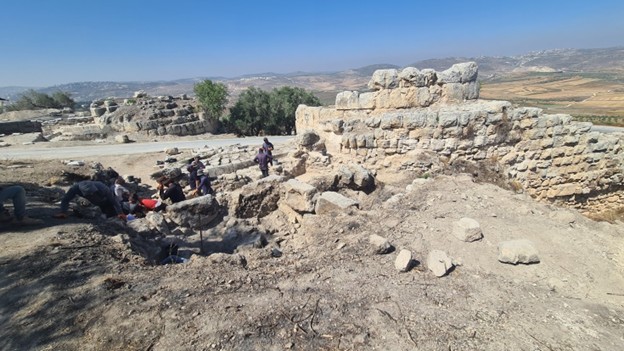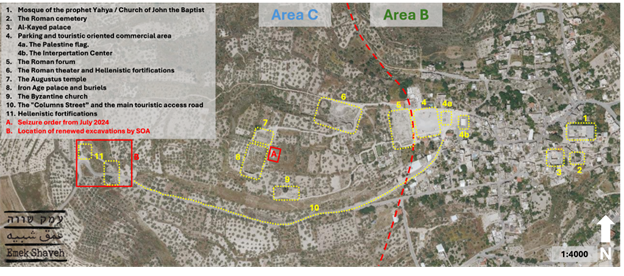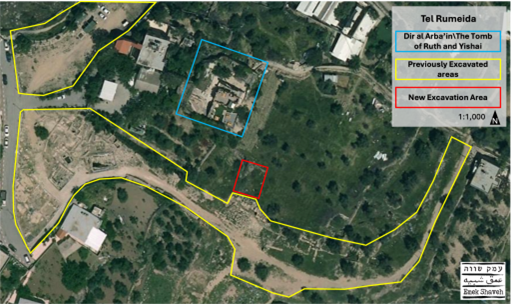Unprecedented number of archaeological site declarations distributed in northern West Bank and more
Unprecedented number of archaeological site declarations distributed in northern West Bank; attempt to boycott Israeli academic institutions rocks European archaeological community and other updates
Update topics:
- Sixty declarations of archaeological sites in northern West Bank represents unprecedented scale of landgrab in the name of protecting antiquities
- European Archaeological Association backs down from boycotting Israeli institutions
- Underground tunnel excavation in City of David/Silwan nicknamed “the Pilgrims’ Road” to be inaugurated (for the second time) in the presence of US Secretary of State Marco Rubio next week.
- “Locked Garden” – City of David settlers’ attraction now locked in violation of High Court decision
- New West Bank Excavations: Hebron, Sebastia and more
- Possible looting of ancient materials at Mt Ebal
Recently issued designations of archaeological areas in Northern West Bank target 60 sites
Last month sixty declarations of archaeological sites were distributed in the northern West Bank in the Nablus area, the largest number of site designation orders disseminated at once in the West Bank that we are aware of. The dates on the declarations vary. While some date as far back as 2013, others were signed in May 2025. All of them were distributed at the end of July and beginning of August this year and uploaded to the Civil Administration’s website on August 10th. While we are still investigating the precise reason these declarations were distributed at this point, there are some discernible trends (outlined below).
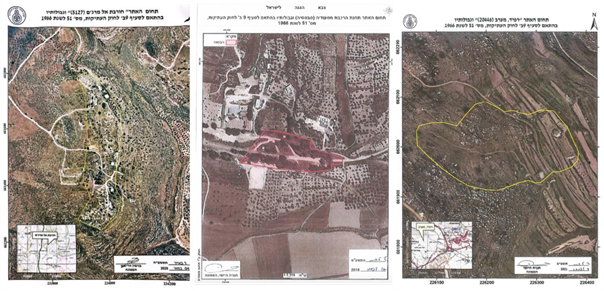
Photos: Various declarations from the file (left: Khirbet Marjame, Middle: Masoudiya train station in Sebastia, Right: Khirbet al Rafid)
The site designations were issued by the Staff Officer for Archaeology (SOA) within the Civil Administration (ICA) who derives his authority from the antiquities law effective in the West Bank (the Jordanian Antiquities Law of 1966). The authority of the SOA is as follows:
- Declaration of antiquity sites, and determining/updating their boundaries.
- Issuing work stoppage orders for any development within the boundaries of a declared site or a site suspected of containing archaeological remains.
- Imposing fines for damage to an antiquity site, whether the site is declared or not.
- Demolishing structures located within a declared antiquity site or one that will be declared in the future.
- Collecting information, investigating, and requesting the arrest of suspects in antiquities theft or illegal antiquities trade.
- According to the Oslo Accords the SOA has jurisdiction only in Area C, but a government decisionfrom last year has authorized the SOA to restrict development and enforce demolition at antiquity sites in Area B as well (more below).
The recent site declarations appeared on the ICA’s website and were distributed to communities on the ground. The ICA does not usually publicise site declarations and we learn about them from the communities who have received them.
Two trends are apparent at this point:
- Declaration of sites in Area B: The site of Mount Ebal situated in Area B of the West Bank was also designated in a recent order. This follows a cabinet decisionfrom July 2024 to authorize the SOA to enforce actions against alleged destruction at antiquity sites in Area B. This decision effectively cancelled governance distinctions in the field of antiquities as mandated by the Oslo Accords whereby the Palestinian Authority has jurisdiction over civil matters – including archaeology – in Area B.
- The number of new declarations is extremely high. Benny Har-Even, the Staff Officer for Archaeology (SOA), and the Deputy Head of the Civil Administration, Hillel Roth, who sits within the Settlement Administration within the Ministry of Defence, signed 31 designations just for the Nablus area in May 2025. This joins the new settlement designations, declarations of state land, a tide of construction permissions and the approval of new settler outposts which followed the creation of the Settlement Administration within the Ministry of Defence under special Minister within the Ministry of Defence Bezalel Smotrich in 2023.
The case of Marjame
Marjame (or Khirbet el-Marjame: 234000/661600) is an archaeological site (about 61,500 sqm or 61.5 dunam) and the site of a small community in area C, a kilometre south west of the town of Duma and two km. from the settler outpost of Malachei Ha’Shalom. The small goat herding community of three families live amongst the antiquities and represent the most recent layer of life in a site containing remains stretching back to the Middle Bronze Age. More recent dwellings consist of light construction. A non-resident who bought a plot of land at the site and tried to introduce more substantial construction faced demolition as a result. Like the other communities in the area, the families from Marjame have faced escalating settler violence, including the torching of one of the homes and a car in March 2025.
Marjame was excavated in the 1970s by the Hebrew University during which Iron Age fortifications were documented. A survey conducted by Bar Ilan University between 2014-2017 documented a wall and the remains of a well-built gate were exposed on the eastern side of the site’s hill. The gate was constructed of large fieldstones, and alongside it were two sections of massive walls that may be interpreted as the remains of square towers. Following the abovementioned construction attempts and demolitions, the SOA initiated “salvage” excavations between 2020-2023. The boundaries of the declaration for Marjame, dated 4th May 2025, includes all the current dwellings.
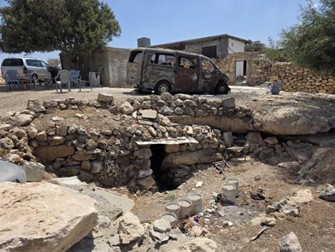
Photos: Various declarations from the file (left: Khirbet Marjame, Middle: Masoudiya train station in Sebastia, Right: Khirbet al Rafid)
Near Marjame, about two and a half km. away is the settler outpost of Malachei Hashalom. The outpost was first established on this site in 2015 and was dismantled several times but in February 2023 the Israeli cabinet decided to grant it official recognition. On June 11th 2025, 800 dunams in and around the outpost were designated as State land.
Emek Shaveh: The sixty site declarations published on the website of the ICA, the largest number of designations issued at once, suggest that the ICA in coordination with regional settler councils is deploying all the available mechanisms to advance a wholesale clearing of Area C from Palestinian communities and also in some cases from Area B. Antiquities are being instrumentalized both as a bureaucratic tool to promote displacement and annexation, and as a means to develop sites where archaeology serves as an anchor for biblical narratives and an exclusive story of Jewish belonging. In this sense, these declarations should be seen within the wider thrust of planning and bureaucratic steps as well as settler violence utilized to force communities to leave their lands.
European Archaeological Association (EAA) backs down from boycotting Israeli institutions following pressure and accusations of anti-semitism
In the last week of August, the European Association of Archaeologists (EAA) published on their designated website for the 31st EAA Annual Meeting (2–6 September) held in Belgrade (for security reasons the meeting was eventually held virtually) a new directive to Israeli colleagues according to which the participation in EAA events can only be permitted as individuals without mention of affiliated institutions. These were the same participation guidelines applied to colleagues from Russia and Belarus
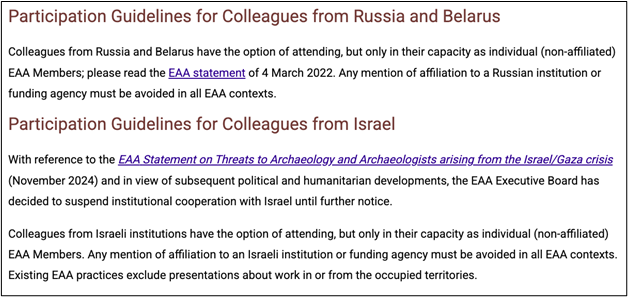
Photo: From the EAA website, screenshot from August 28th – can be found via the internet archive website. The guidelines for Israelis were taken down.
The directive made reference to the EAA statement from November 2024 regarding the Gaza war. What followed was a campaign of hundreds of archaeologists calling on the EAA to rescind the decision, and by September 2nd the directive was erased from the website.
The November statement had included the following:
“We call upon all parties to such conflicts – whether directly involved or acting in support of combatants – to consider, among their concerns, the implementation of appropriate strategies to safeguard the cultural heritages of the region. We implore them to adhere to the Hague Conventions on the Protection of Cultural Property in the Event of Armed Conflict (1954) and its First (1954) and Second Protocols (1999) and other relevant materials and rules. It is crucial that armed operations avoid targeting archaeological and cultural heritage sites, and maintain a safe distance from their immediate surroundings.
We strongly denounce the use of archaeological heritage to promote and establish political, ideological or national agendas, in particular to support claims to land. This applies especially to invasive undertakings like archaeological fieldwork, such as suggested by a recently submitted draft law, which aims at amending the Israel Antiquities Authority Law to expand the Authority’s jurisdiction into the West Bank to ‘protect Jewish cultural heritage’. We urgently call for compliance with international law, agreements and conventions and for the integrity and objectivity of archaeological research to be preserved.”
The exchange of emails that led to the cancellation of the directive included accusations of antisemitism and biased and unfair enforcement of ethical standards. One of the arguments made was that scholars should not be punished for actions of their government – which they themselves oppose and protest against.
In an article in Haaretz (Hebrew) about the wave of boycotts faced by the Israeli archaeological community since the war in Gaza began, Emek Shaveh’s Executive Director, Alon Arad, responded to the drama at the EAA as follows:
“This decision is a bill presented for many years of wrongdoing, I understand the claim made by Israeli archaeologists that this decision has nothing to do with archaeology, and that it is part of a global wave. They are right. But they are also being disingenuous. Unlike sociologists, for example, Israeli archaeologists cannot invoke the defense of good faith. All universities in Israel conduct archaeological activity beyond the Green Line. The community stubbornly refuses to look critically at itself—what are we doing? With whom are we collaborating? From whom are we taking money? I suggest treating the EAA’s statement as a yellow card for Israeli archaeology,” he added, pointing to a long list of international conventions, UN resolutions, and decisions of the International Court of Justice in The Hague, which, he says, are constantly being violated by Israeli archaeologists.”
Chairperson of our board, Professor Rafi Greenberg from Tel Aviv University said:
“Since no Israeli archaeological institution or organization has disavowed the war crimes committed in our name, and the violations of international law carried out by our archaeologists, we can expect more of the same in the near future.”
Underground tunnel excavation in City of David/Silwan nicknamed “the Pilgrims’ Road” to be Inaugurated (for the second time) in the presence of US Secretary of State Marco Rubio on Monday
The City of David (Ir David) Foundation known as Elad, the settler organisation seeking to Judaise the Historic Basin and who run the City of David archaeological park in Silwan are planning an inauguration ceremony of the “Pilgrim’s Road”, the nickname for a first century Roman Road excavated beneath the main street of Silwan’s Wadi Hilweh neighborhood. Set for Monday, 15th of September 2025, the inauguration is scheduled to be attended by the US Secretary of State Marco Rubio, which would make him the highest ranking foreign official to visit the settler controlled site.
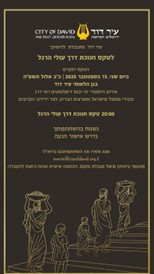
Photo: From the EAA website, screenshot from August 28th – can be found via the internet archive website. The guidelines for Israelis were taken down.
Invitation to the inauguration of the “Pilgrims’ Road” scheduled for September, 15th at 20.00. The invitation says the “historic event will be attended by high ranking diplomats and senior members of the Israeli and US governments.”
The Elad Foundation who initiated the works have been working with the Nature and Parks Authority (INPA) and the Israel Antiquities Authority (IAA) on the Roman road presenting it as the ancient route which led pilgrims to the Second Temple. The digging of the Roman Road has been conducted as a horizontal excavation, a practice which has not been considered a legitimate scientific archaeological method for over a hundred years. It was replaced by the stratigraphic method whereby digging is carried out vertically from the surface level down into the ground affording better understanding of the archaeological finds and the different layers, and preventing unnecessary damage and destruction.
The “Pilgrims’ Road” has been inaugurated already once before in 2019 in the presence of former US Ambassador to Israel, David Friedman.
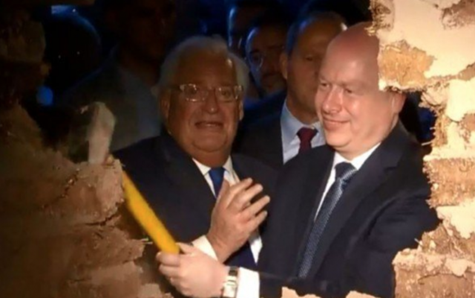
Former US Ambassador to Israel David Friedman (L) and former White House Middle East envoy Jason Greenblatt break down a specially built wall in front of the Pilgrimage Road, at a ceremony on June 30, 2019. (Facebook/Screen capture as seen in the Times of Israel)
In 2020 we published a report (Fissures and Cracks – Damage to homes in the Wadi Hilweh neighborhood of Silwan) about the damage to homes in Silwan resulting from the excavations. The INPA and IAA refused to take responsibility saying the excavations were conducted under “meticulous engineering oversight”.
“Locked Garden” – City of David settlers attraction being locked against the law
As part of Emek Shaveh’s ongoing monitoring of the “City of David” archaeological park, we discovered that new gates were placed in the entrance to the park and that the main entrance was now locked from 17.00 every day including weekends. The locking of the park was justified to us by claims of “vandalism by locals”.
The City of David national park is located in the heart of a populated urban neighbourhood of Wadi Hilweh in Silwan. Large swaths of the park’s land were once the public areas within a Palestinian neighborhood that suffers from chronic deficiency of such areas. In 2015, Emek Shaveh and local residents petitioned the High Court against the Elad Foundation and the Nature and Parks Authority against the erection of gates that closed off certain sections of the park after hours that had hitherto remained accessible to residents. In response, the High Court ruled that the gates may remain as access is enabled through other entrances. The new gates now enable locking the entire site, preventing the locals from accessing what had once been central public areas.
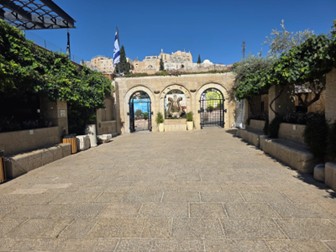
Gates placed at main entrance to the City of David visitors’ centre enabling the locking of the site after hours despite a High Court ruling from 2020 (Photo taken September 2025).
New West Bank Excavations: Hebron, Sebastia and more
During recent months we identified a surge of excavations, mainly conducted by the SOA and defined as “salvage” excavations.
The excavations began at the site of Sebastia in May as the first stage in an implementation of government decision (no. 491 from May, 2023) to develop the acropolis of Sebastia—referred to in Hebrew as the “Shomron National Park”—with an allocated budget of 32 million shekels.
The Sebastia site is intended to be developed into a major tourism destination in the northern West Bank. According to the plan, the site, which is in Area C, will be severed from the historic town of Sebastia, situated in Area B. If realized, it will sever the historic expanse into two. The town and the acropolis are on the tentative list of World Heritage Sites for the State of Palestine.
A new excavation in the Tel Rumeida neighborhood in Hebron on private land also commenced in May. Tel Rumeida is identified with the emergence of the city of Hebron, approximately 4,000 years ago and it is situated in the buffer zone of the UNESCO World Heritage Site of Hebron/al Khalil Old Town declared in 2017. Earlier excavations in Tel Rumeida paved the way for an archaeological park which opened to the public in 2018. It is operated by the Civil Administration’s Staff Officer for Parks under the auspices of the Nature and Parks Authority.
Tel Rumeida is populated mostly by Palestinians with a minority of Israeli settlers. The new excavation was joined in August by a new settlement and the takeover of a Palestinian house in March as reported by Peace Now. Taken together, the archaeological park, the new excavation area and the new settlement link to the older settlement in Tel Rumeida significantly enlarging the expanse of Israeli-settler control in Tel Rumeida.
To read our report on destructive developments in the heart of the World Heritage site and in Tel Rumeida in the World Heritage Watch 2024 report see here, p,88.
Additional excavations in West Bank sites have begun at Kh. er-Rabiya, Kh. Luzifar, Kh. el-Rafid, Hizma, Kh. en-Nabi ‘Aner and Givon Hahadasha (New Givon).
While all of these excavations, along with those in Sebastia and Tel Rumeida are defined as “salvage excavations” we would like to remind of the conclusion provided in the Report of the Independent International Commission of Inquiry on the Occupied Palestinian Territory, including East Jerusalem, and Israel about attacks on educational facilities and religious and cultural sites (A/HRC/59/26):
“The Commission has documented many incidents in which Israeli officials have: seized or allowed settlers to seize cultural heritage sites; excavated, developed and expanded such sites for tourism purposes, including those containing artefacts representing various cultures and periods in history, while excluding non-Jewish history; and blocked or severely restricted Palestinians from accessing such sites. In some cases, archaeological excavations that were described as “rescue excavations” led to the subsequent opening of tourist sites by Israeli authorities” (section 59, page 10).
Possible looting of ancient materials at Mt. Ebal
Since March 2025, a new trend has emerged, led by settler leader Yossi Dagan (head of the Samaria Regional Council), of giving gifts made from stones allegedly from the archaeological site on Mount Ebal. This site is located in Area B of the West Bank, near Nablus.
The first recipient was televangelist Paula White-Cain, who received a mezuzah. In May 2025, Yossi Dagan and the U.S. Ambassador Mike Huckabee affixed a mezuzah made from stones from the site to the door of the Ambassador’s office. Last week, Dagan gave the same type of mezuzah to Hungarian Minister of Foreign Affairs, Péter Szijjártó.
The site was first identified in the 1980s by Israeli archaeologist Adam Zertal, who claimed it was associated with the biblical story of Joshua. However, this interpretation is overwhelmingly disputed by archaeologists. Despite the ongoing academic debate, since 2019, settlers have been campaigning to change the site’s status.
The site has allegedly been a target of looting by settlers, also allegedly in cooperation with American evangelical archaeologist Scott Stripling. These activities have been sponsored by the SOA (Staff Office for Archaeology) unit of the ICA.
The extraction of materials from a known archaeological site without a license is prohibited under local and international law. The Oslo Accords stipulated that the responsibility for antiquity sites in Area B fall under the Palestinian Authority’s Department of Archaeology and Cultural Heritage (DACH), not the SOA, and DACH did not issue an excavation permit.
According to international law, the removal of materials from cultural heritage sites in occupied territory is prohibited by international conventions, primarily the 1954 Hague Convention and its two protocols and the 1970 UNESCO Convention on the Means of Prohibiting and Preventing the Illicit Import, Export and Transfer of Ownership of Cultural Property.
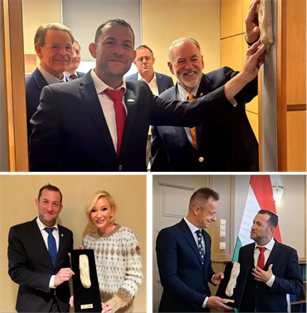
Samaria Regional Council Head, Yossi Dagan, gifting a mezuzah made of stones from Mt. Ebal. (Top right with US Ambassador to Israel Mike Huckabee, bottom left with Paula White-Cain and bottom right with Hungarian Minister of Foreign Affairs, Péter Szijjártó).
Emek Shaveh:
Mount Ebal is an archaeological site located in Area B of the West Bank, under the responsibility of the Palestinian Authority’s Department of Archaeology and Cultural Heritage. The stones from the site are not Israel’s to give away. Any extraction of material from the site without authorization constitutes a blatant violation of the Oslo Accords and binding international conventions, including the 1954 Hague Convention and the 1970 UNESCO Convention.
The gifting of these stones is yet another, particularly cynical, example of how archaeology is weaponised in the settlers’ campaign to justify annexation and the clearing of Palestinians from the land. It is unfortunate that countries who have themselves ratified the 1954 Hague Convention and the 1970 UNESCO Convention are cooperating with these violations and undermining the very frameworks they pledged to uphold.

